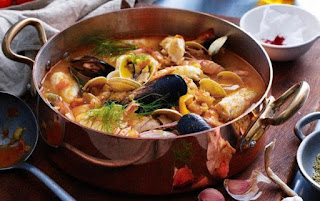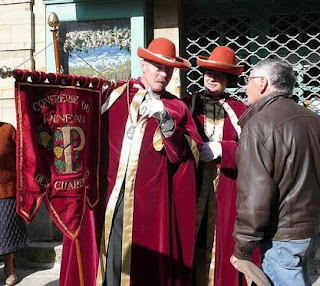from
Behind the French Menu
by
Bryan G. Newman
behindthefrenchmenu@gmail.com
Marmite de Poissons aux Coquillages
A fish and crustacean marmite.
Marmite – Marmite in traditional French cuisine is a seafood and or salt water fish soup or stew as well as the name of the traditional French cooking pot used for making these soups and stews. Petit marmites are smaller cooking pots and are often used for serving the soups or stews they contain. Marmites made with vegetables, meat or poultry are exceptions, but they will be seen on some menus.
Marmite de Poissons – A fish marmite
Photograph courtesy of Blog de mihibou
(French Marmites and petite marmites have nothing to do with the UK Marmite vegetarian spread and flavoring that was first produced in 1902 by the Marmite Food Company. French marmites were on French menus over 100 years before. See the end of this post for more on British Marmite).
Marmites on French Menus
Marmite aux Poissons et Fruits de Mer: – A shellfish and sea-fish soup. There is no single recipe for a marmite with fish and shellfish so ask for more detail about what’s being offered.
La Marmite de Poissons
Marmite Dieppoise – A traditional fish soup from the port town of Dieppe in Normandy. This marmite will be mostly sea fish; some will include mussels and the occasional scallop for good luck. The soup, when made locally, will be made from that day’s catch; the catch may change daily and then so will your soup’s taste. The Marmite Dieppoise generally has a white wine and cream or crème fraîche base; additional flavor will be added with herbs, shallots, and vegetables that the chef considers suitable.
Cassoulet petite marmite with Toulouse sausages.
Marmite du Pêcheur – A fisherman’s marmite from the North-East of France. From my experience, it is somewhat similar to the Marmite Dieppoise. On a visit to Lille, in Northern France, I had a perfect Marmite du Pêcheur and was told that the fish were whiting and plaice. The soup was excellent and came with lots of mussels, some cockles, and small clams all cooked with white wine, carrots, onions and what seemed like a lot of garlic; excellent.
Marmite de Saint Jacques et Lotte à la Bretonne – A marmite of king scallops and monkfish in the manner of Brittany. This is a marmite with the best of Brittany shellfish and seawater fish with the Brittany accent coming from crème fraiche and quite probably their excellent cider.
La Marmite Bretonne
Marmite de Ris de Veau à la Bière d'Ardennes Ambrée et Champignons Frais – A marmite of veal sweetbreads made with the amber colored beer from the Ardennes and fresh button mushrooms.
Petite Marmite de Homard aux Girolles – A petite marmite of the two-clawed European lobster and girolle chanterelle mushrooms.
La Marmite de Poulet Fermier aux Girolles – A stew of farm raised chicken prepared with chanterelle mushrooms.
Marmite de Bouillon de Poule
A marmite made with a chicken bouillon
Petite Marmites
Petite marmites are the name given to similar and smaller, cooking pots than those called a marmite without any prefix. The stew cooked in a petite marmite will often be served in it. The traditional shapes used for the pots called marmites and petite marmites have long gone, but the recipes remain.
The British vegetarian spread and flavoring called Marmite,
Before Louis Pasteur realized that the cells in yeast were, in fact, living plants, people just discarded the yeast as a by-product of the brewing process. Then the German scientist Justus von Liebig (1803-1873) went on to make yeast into a concentrated vegetarian food product that was said to taste like meat extract. This is the discovery that laid the groundwork for the production of British Marmite some thirty years later. Following on Marmite’s commercial success came the discovery of vitamins in 1912; that gave Marmite another boost as it was found to be a great source of five important B vitamins. Much later, in 1929, the Nobel Prize committee award the prize for the discovery of vitamins to two among the many deserving researchers who were still alive: Sir Frederick Gowland Hopkins from England and Christiaan Eijkman from Holland. The Marmite factory in Burton-on-Trent, on the River Trent in East Staffordshire, England was established in 1902, it is still there today.
A jar of British Marmite
Connected Posts:
Behind the French Menu
by
Bryan G. Newman
behindthefrenchmenu@gmail.com
Copyright 2010, 2017.
















